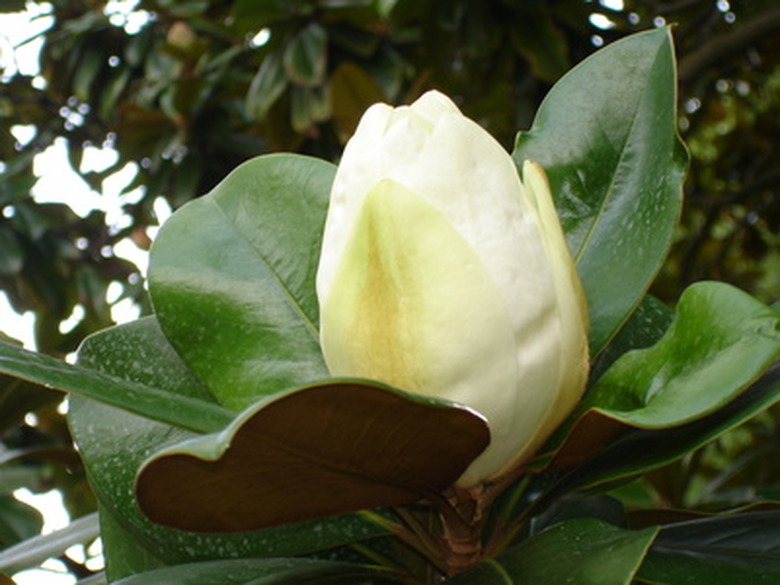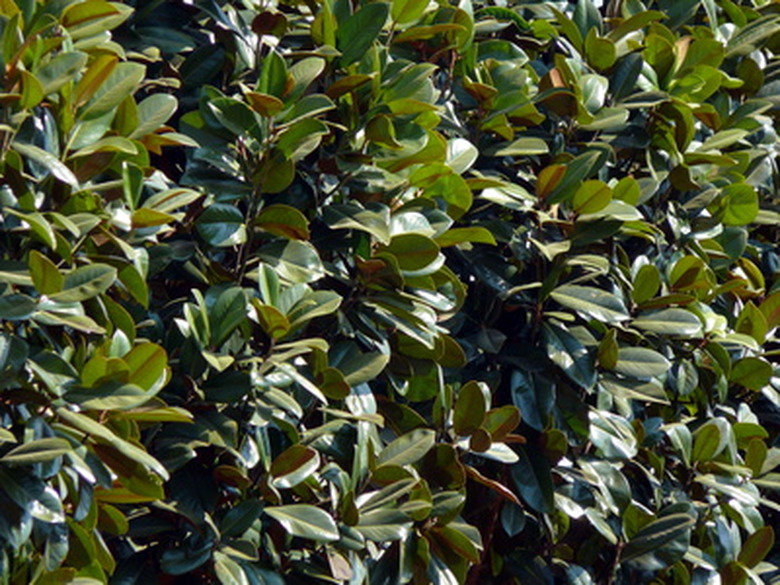The Speed Of Growth Of A Magnolia Tree
The Southern magnolia (Magnolia grandiflora) is breathtaking at its full maturity: The deep green, glossy leaves cover graceful branches. Its branches spread outward to create a lush, full tree with a stately look. The large, fragrant white blossoms that cover the tree in late spring and early summer are showstoppers. Magnolia trees grow at a relatively fast rate in their preferred climate, which ranges from warm to semitropical, but their rate of growth is affected by soil type and weather conditions. The rate of growth will be slower in cooler climates.
Types
There are three types of growth involved in measuring the speed of growth of a magnolia tree. The first is height, the most obvious indicator of growth, and it simply indicates the total measurement of the tree from the uppermost branch to the base of the trunk where it meets the ground. The second type of growth is trunk growth, which may be measured by the increase in either the circumference or diameter of the trunk. The third type of growth is in spread, the total area that is taken up by the branches of the tree. Some trees have an erect growth pattern: their branches will taper off toward the's trees tip, creating a triangular shape. Other trees, including the magnolia, have a spreading growth pattern: their branches outward from tree top to bottom without a distinct tapering pattern.
- The Southern magnolia (Magnolia grandiflora) is breathtaking at its full maturity: The deep green, glossy leaves cover graceful branches.
- Other trees, including the magnolia, have a spreading growth pattern: their branches outward from tree top to bottom without a distinct tapering pattern.
Time Frame
The Southern magnolia grows at a rate known as moderately fast in the gardening world; in normal growing conditions, it will average a full foot of growth in height every year. The magnolia is a medium-sized tree, meaning that its full height ranges from 35 to 60 feet and its spread can reach about 15 feet around. Magnolias usually average about 0.2 inches of diameter growth per year. Growth slows when the tree has aged to about 50 years old.
Geography
The speed of growth of a magnolia tree will vary depending on where it is being grown. As the name indicates, the magnolia is a Southern native. It grows best (and thus, fastest) in the Southeast of the United States: the lower parts of Texas, Louisiana, Mississippi, Alabama and Georgia, and the Florida Panhandle. These regions range from warm temperate to semitropical. In such areas, the growth of a Magnolia tree should proceed along at an average of 1 foot in height per year under normal growing conditions. Growing a magnolia tree in cooler zones is possible, but the growth rate will be much slower.
- The Southern magnolia grows at a rate known as moderately fast in the gardening world; in normal growing conditions, it will average a full foot of growth in height every year.
Considerations
Other factors that affect the speed of growth of a magnolia include soil conditions and weather conditions. The magnolia prefers a rich soil with a good degree of moisture, such as that found along streams and in swamps. Heavy clay soil can slow root growth, thus diminishing height growth. Likewise, a soil that is too sandy, rocky and lacking in nutrients will slow the overall growth rate as well. Weather is the other factor: Though the magnolia is tolerant of heat, it still needs water in order to grow. Drought will diminish growth; during periods of drought, water your magnolia weekly until the ground around it is soaked.
Expert Insight
Winter drought can slow the spring-time growth of a magnolia tree, says Kenneth W. Outcalt (USDA Forest Service). Extreme winter drought can cause the tree to die back in winter. In spring, the tree has to do a lot of "catching up" to attain its former height; it may not produce any additional growth in height or spread for the year. To keep growth on track, remember that a magnolia tree needs water even during the colder winter months. During winter drought (absence of snow or rain), water bimonthly, soaking the ground around the tree. Outcalt also states that a particular variety of the Southern magnolia, M. grandiflora gallissoniensis, is said to be cold-hardy and may produce better growth in the cooler climates.
- Other factors that affect the speed of growth of a magnolia include soil conditions and weather conditions.
- Outcalt also states that a particular variety of the Southern magnolia, M. grandiflora gallissoniensis, is said to be cold-hardy and may produce better growth in the cooler climates.

